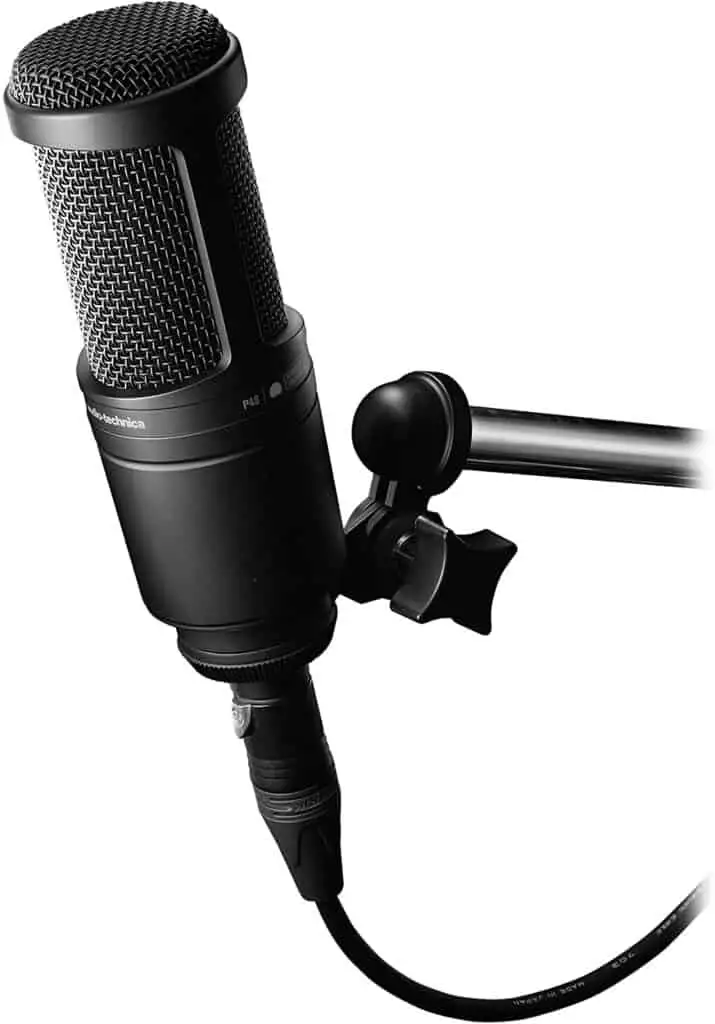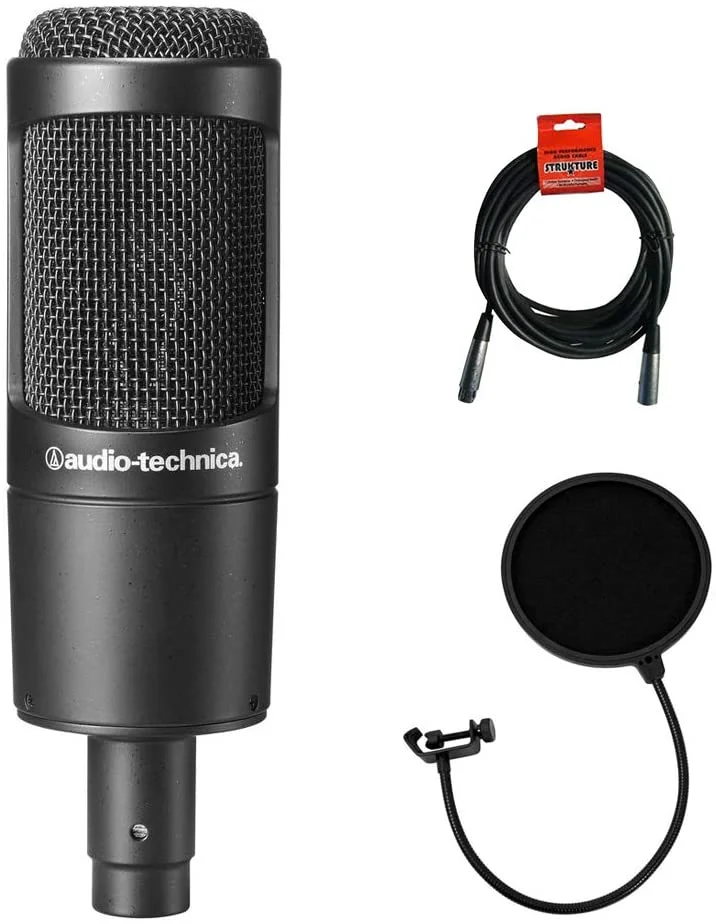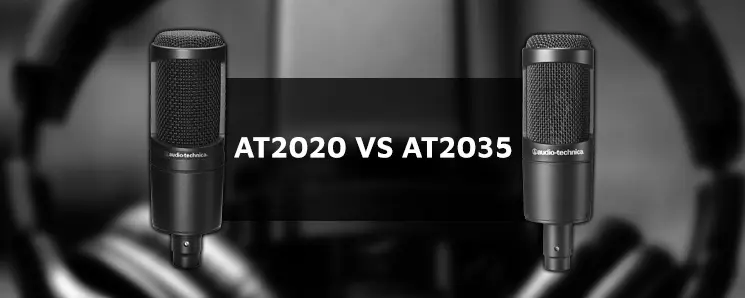- Free Clarity Stream Deck Icons - April 11, 2022
- Cheap Streaming PC Build - April 10, 2022
- Shure SM7B Microphone Review - April 8, 2022
Trying to figure out the difference between these two microphones? The AT2020 vs AT2035 review will answer all your questions.
AT2020 vs AT2035 – What’s the Difference?
If you’re a content creator, then you can’t do without a microphone. And when it comes to mics, there’s no better entry than an Audio Technica.
Today, we’re here to present a comparison between two popular mics from the brand. We’ll be pitting the AT2020, which has been in the market for almost ten years, against the AT2035, which is the pricier, revamped version.
Both are popular mics and have similar technology working behind the scenes. Yet, when it comes to performance and price, there are differences between the two that must be acknowledged.
But which one of these two is better for your needs? What do you need to keep in mind when making a choice? That’s what we’re going to discuss here.
The AT2035 Cardioid Condenser Microphone Bundle from Audio-Technica features a side-address design and can be used in the critical home, project, or professional studio applications as well as live performances.
So, let’s compare them below!
Comparison Table – Audio Technica AT2020 vs AT2035




Best Budget – Audio-Technica AT2020 Microphone

Audio-Technica AT2020
- The price/performance standard in side-address studio condenser microphone technology
- Ideal for project/home-studio applications; The noise level is 20 dB SPL
- High SPL handling and wide dynamic range provide unmatched versatility
- Custom engineered low mass diaphragm provides extended frequency response and superior transient response
- Cardioid polar pattern reduces pickup of sounds from the sides and rear, improving isolation of desired sound source. Output connector: integral 3 pin XLRM type
Pros
- Records sound with unmatched clarity
- Highly versatile
- Extremely sound-sensitive
Cons
- Doesn’t come with a shock mount
As we mentioned already, the AT2020 has introduced over ten years ago, but it’s still one of the most preferred mics worldwide. Whether you’re a streamer, singer, or podcaster, you can be sure to have heard this mic at least once in your life.
This is Audio Technica’s original, entry-level microphone that uses a cardioid condenser technology. It’s a traditional XLR mic, which means you’ll need to install an additional audio interface if you want to record into a computer.
The defining feature of this mic is the vocal recording feature, which successfully captures the source’s essence. Highly precise in its recordings, this microphone is known for producing extremely accurate representations of the source sound.
Perfect for podcasting, streaming, recording, and for any other vocal work, the AT2020 is a versatile device that gets the job done. Below, we explore the various features of this product across the design and performance parameters.
Audio-Technica AT2020 Design
In a nutshell, AT2020 has an elegant design. The device is black and has been manufactured out of premium-grade cast iron. There are two levels of wire meshing that protect the main condenser capsule, and the glossy finish makes the product all the more attractive.
From one look at the build quality, one can quickly tell that this is a mic that will last for a very long time. The construction is solid, and it comes with all the required accessories that you may need in your recording task.
The pivoting stand mount that the mic uses is compatible with most mic stands. This means, when you buy the AT2020, you won’t have to spend on another mic stand that fits your new recording essential.
As we already mentioned, this mic uses a cardioid polar pattern, which makes it more sensitive at the front than the back. This helps to isolate and eliminate unnecessary background noises that may disrupt the recording process.
One more thing to mention: the AT2020 requires phantom power to operate. And yes, with a frequency response range of 20Hz-20KHz, this mic can record all sounds within the human auditory range.
Audio-Technica AT2020 Performance
Now that we have the design under grasp, let’s spend some time analyzing its performance. The AT2020 is the first model in the AT20 series, hence its performance is rather basic when compared to other advanced options.
But that doesn’t mean it delivers a subpar performance, far from it. If you have a personal recording setup and want to add a decently performing mic without breaking the bank, this one can be your best bet.
We found the frequency response to be rather flat, which is a good thing. There are some subtle cuts around the 70-80Hz region, but the higher ends of the frequency spectrum get a significant boost, enhancing the overall clarity.
Due to the cardioid design, it can easily pick up noises from the front, while eliminating side and back noises. That being said, as the AT2020 is a condenser mic, it’s not a suitable choice for recording in places that have a large number of natural sounds.
We’d say it’s more useful in a studio setting, where background noises can be controlled. Smart, versatile, and effortless to use, the AT2020 is a versatile recording tool that can come in handy in any situation.
With rugged construction for durable performance, the microphone offers a wide dynamic range and handles high SPLs with ease. The AT2020: the new standard for affordable side-address studio condensers.
So, now you know all about this microphone. What about the AT2035? How does it compare? Is the higher price point justified in its case? That’s what we’re going to explore in the next section.
Best Overall – Audio Technica AT2035 Microphone

Designed to be the snappier successor of the AT2020, the AT2035 builds upon the original’s design. Equipped with similar technology and comparable build quality, but a much superior performance, the AT2035 is easily one of the best available mics for professionals.
Like the older model, the AT2035 also boasts an excellent cardioid pickup pattern, condenser-based design, and cast iron construction. It also successfully rejects any noise from the sides or back.
This microphone aims to capture neutral-tone audio without technical embellishments. This makes the sounds more comfortable to capture. It also helps post-production editing of any tonal characteristics.
However, as anyone who has heard recordings made on the two will readily testify, the sound quality is far better than its predecessor. It also has minor differences with the AT2020 in terms of impedance, wide dynamic range, and other parameters, as we will explore next.
With rugged construction for durable performance, the microphone offers a wide dynamic range and handles high SPLs with ease. The AT2020: the new standard for affordable side-address studio condensers.
Audio-Technica AT2035 Design
When it comes to the design department, both the mics are comparable. The AT2035 has a polished black design similar to the AT2020, but being a newer model, it looks thinner and sleeker.
The impedance level is 120 ohms, whereas the impedance of the previous model caps at 100 ohms. What’s more, this mic has a dynamic range of 136dB. In comparison, the AT2020’s range falls at 124dB.
Another significant point, where the newer model scores over the older, is in that it includes a 10dB Pad and a High-Pass Filter. Also, for the audio interface power requirements, the AT2035 requires 11-52V DC of phantom power, whereas the AT2020 requires 48V DC.
While we are talking about design differences, we must also mention that this microphone comes with a shock mount. This is an essential requirement when looked at from the point of practicality. Plus, the new model has a better carry case, which makes taking it from place to place a cinch.
Overall, we can say that both models are more or less neck-to-neck in terms of design. While both have the same basic construction, there are differences here and there that make the AT2035 a better option.
But what about performance? Just because the AT2035 is the newer offering doesn’t mean it’s going to perform better, does it? Well, let’s move on to the next section and settle this argument once and for all.
The AT2035 Cardioid Condenser Microphone Bundle from Audio-Technica features a side-address design and can be used in the critical home, project, or professional studio applications as well as live performances.
Audio-Technica AT2035 Performance
The AT2020 is a good mic with excellent features, but no matter what, there’s always room for improvement, right? And that’s precisely what the AT2035 is. Priced higher, it also offers significantly improved sound quality.
One of the distinguishing features of this newer model is the 80Hz High-Pass Filter, which helps to weed out low-level noises and give a clearer sound quality. Plus, the 10dB pad ensures that you can cut off the lower frequencies should you wish to.
This can be quite helpful when you’re trying to record content or eliminate ambient noise that may be a nuisance. While some might argue that this is not an essential feature of the mic itself as it can be done post-production, we think it’s a handy option.
Next, we come to the device’s noise sensitivity, which is astounding, in our opinion. The mic has a clear signal reception, and due to an integrated cardioid design as opposed to a cardioid mode, it is perfectly able to record all the subtleties of the target source.
This means with the AT2035; you have as close a representation of the actual sound source as is possible to record. Plus, it also has lower self-noise and lower background noise, which further increases the quality of the recording and pushes you closer to studio recording level quality.
Frequently Asked Questions
1. Which One Is More Durable?
When it comes to the design of the Audio Technica AT2020 vs AT2035, the AT2020 has a reliable build quality that ensures long-term performance. The same, of course, can also be said for the AT2035.
Though it is sleeker, it’s built out of the same cast iron material. Overall, we can say that both mics are equally robust when considered from the durability point of view.
2. Is the AT2035 Worth the Extra Price?
When you take into account the fact that the AT2035 has a far superior recording quality than the AT2020, shelling out the extra cash is practically a no-brainer. For such high-grade performance, the investment is certainly worth it.
3. I Already Have a Microphone Stand. Do I Need to Invest in a Special One for Either Model?
Not at all! Both the AT2020 and AT2035 can be fixed on most standard microphone stands. So, you don’t need to invest in a separate model unless your mic stand isn’t compatible with them (which is not likely to be the case).
In Conclusion
Now, we have to tackle the most crucial question of all, which one of these condenser microphones should you buy? The At2020 vs AT2035. The answer, though seemingly complicated, is a no-brainer.
Both microphones have comparable designs, but the difference is noticeable when it comes to performance. The AT2035 is a superior device, with better clarity, ease of use, and more natural recording and sounding capability.
What’s more, it even comes with the High Pass Filter and 10dB pads that make the recording process smoother. We’d say that it is undoubtedly worth the extra cash that you’d have to shell out.
However, if you’re just an entry-level user and don’t want to spend a lot, then, by all means, go for the AT2020 microphone. It’s affordable, but doesn’t compromise on the sound quality of your recording and delivers reliable performance.
The AT2035 microphone is certainly flatter than its predecessor, which is an advantage since this makes post-production changes a breeze. Overall, the AT2035 vs AT2020 has a more natural sound reception than the older model, which certainly justifies the increased price tag.
The AT2035 Cardioid Condenser Microphone Bundle from Audio-Technica features a side-address design and can be used in the critical home, project, or professional studio applications as well as live performances.
Continue reading:
HyperX QuadCast vs Blue Yeti – What’s the Best Mic?


